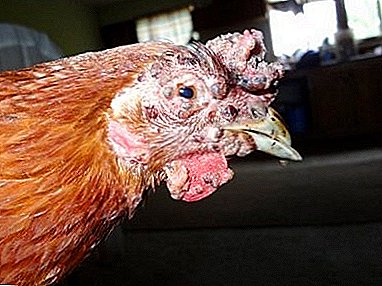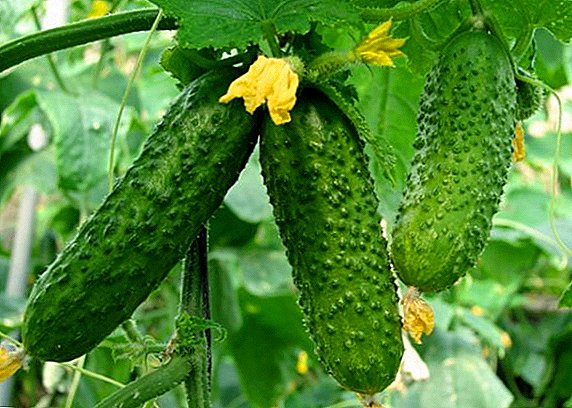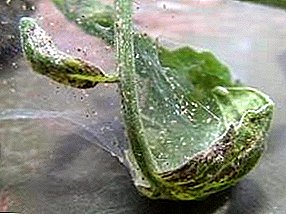
Chicken pox is a very common viral disease caused by a pathogen belonging to the genus "Avipoxvirus". As a rule, accompanied by the appearance of conjunctivitis in birds, as well as various rashes on the skin and mucous membranes.
In this article we will talk in detail about what this disease is, what its symptoms are, whether smallpox can be diagnosed independently and what measures the treatment and prevention can take by the farmer.
Forms of smallpox in birds
 There are several forms of manifestation of this disease in chickens, each of which differs in a number of specific signs, as well as in the percentage of mortality among birds.
There are several forms of manifestation of this disease in chickens, each of which differs in a number of specific signs, as well as in the percentage of mortality among birds.
So, consider them in detail.:
- Skin form (also called smallpox) - this form is considered the easiest and with timely treatment is not able to cause significant harm to the herd.
For the skin form of chicken pox is characterized by the appearance of birds on bare areas of the body (earrings, comb, base of beak, areas around the eyes) growths, which in their appearance resemble warts covered with blood scabs.
As a rule, this form of the disease disappears in 5-6 weeks and has a very favorable prognosis, as it proceeds without complications. In addition, smallpox is localized exclusively on the head of the bird.
REFERENCE. On average, the mortality rate of chickens from the skin form of smallpox is no more than 8%. - Diphtheria form of smallpox - is the most severe type of disease and is characterized by a high percentage of bird mortality (up to 50%).
The following symptoms are characteristic of this form of chicken pox::
- defeat ulcers of the oral strip, esophagus, larynx, as well as chicken trachea;
- heavy breathing, accompanied by a whistle;
- cough, wheeze;
- the bird constantly pulls the neck;
- open beak;
- the bird refuses to feed;
- the appearance of rhinitis with yellow secretions (when diphtheria smallpox struck the nasal mucosa);
- the appearance of thick puffiness around the eyes with pus;
- swelling of the eyelids;
- profuse lacrimation, etc.
IMPORTANT. In the presence of adverse conditions, the mortality rate in the herd of diphtheria smallpox can reach 70%. An important role here is played by the age of the birds, the quality of food, as well as the conditions of detention.
- Mixed form - has signs characteristic of both the skin form of chicken pox and diphtheria. As a rule, changes are found on the skin of birds and on mucous membranes. In this form of the disease, the mortality of birds is from 30 to 50%.
Causes and methods of transmission
 It should be noted that chicken pox may develop as a result of penetration into the herd of the pathogen from the outside, or because of a pathogen that has already been among birds for some time. At the same time, the main source of this disease is sick or ill individuals.
It should be noted that chicken pox may develop as a result of penetration into the herd of the pathogen from the outside, or because of a pathogen that has already been among birds for some time. At the same time, the main source of this disease is sick or ill individuals.
There are the following ways of transmission of chicken pox:
- contact of sick birds with healthy ones;
- use of contaminated inventory;
- contact with rodents or wild birds, which are often carriers of this disease;
- through ticks, mosquitoes and other insects whose chickens are exposed to bites;
- through feces, water, feed, feathers, down, and infected farmer clothes.
It should also be noted that the causative agent of chicken pox can penetrate through damage to the skin or mucous membranes of birds.
Diagnostics
Despite the fact that the signs of chicken pox can be identified already at a preliminary examination of the bird, nevertheless, for a correct diagnosis, it is necessary to use more accurate diagnostic methods.
Chicken pox is usually diagnosed using histopathology of lesions. In this case, a characteristic sign of the presence of this disease is the identification of intracytoplasmic bodies.
Methods of treatment and prevention
 In order to prevent the occurrence of this disease in the herd, it is important to carry out a number of preventive measures which boil down to the following:
In order to prevent the occurrence of this disease in the herd, it is important to carry out a number of preventive measures which boil down to the following:
- The implementation of vaccination, both young and adult individuals - this measure is the most effective. Thus, the vaccine can be made chickens, starting from the age of 7 weeks. The most effective are such vaccines as: "VGNKI", "Nobilis", "FOWL Pox".
The dosage per 1 bird is 0.01 ml of the drug. Enter should be in the wing membrane. After 7-10 days, it is necessary to examine the specimens for the presence of a crust or swelling at the injection site.
ATTENTION. If there are no traces in the injection site, then, accordingly, it can be concluded that the vaccine is of poor quality, or was introduced incorrectly. It is also possible that chickens have already been vaccinated. - The coop must be kept clean and regularly disinfected.
- To prevent the possibility of contact of birds with rodents.
- If diseased chickens were detected, they should be immediately isolated from healthy individuals.
- It is necessary to make a thorough disinfection of inventory, as well as clothing that is used to work on the farm.
If, however, diseased birds were found in the herd, treatment must be made in the following way:
- sick and healthy birds should be given along with water with “Anfluron” (dosage is 2 ml per 1 l of liquid for 3 days);
- the house should be thoroughly treated with an aqueous solution of formaldehyde (40%) or lime (20%).
It is important to note that the treatment of sick birds will have an effect only at the onset of the disease. In this case, the meat of sick chickens should not be eaten, and eggs should be used for incubation.
The most correct decision would be to send sick individuals for slaughter, and to vaccinate healthy ones as a matter of urgency..
We offer you a video about chicken pox:
Economic harm of a disease or why vaccination is recommended
 It should be noted that chicken pox can cause significant harm from an economic point of view, as it leads to extinction of up to half of the herd, and is also characterized by a significant decrease in egg production in birds.
It should be noted that chicken pox can cause significant harm from an economic point of view, as it leads to extinction of up to half of the herd, and is also characterized by a significant decrease in egg production in birds.
For example, in Holland, chicken pox causes 12% of the total number of all losses in the poultry industry.
In addition, appearing in the herd at least once, the disease returns again and again, causing a high percentage of morbidity and mortality among birds.
Thus, as noted earlier, timely vaccination is the most effective way to fight chicken pox. This measure will allow to reliably protect the "chicken kingdom" from this dangerous illness.
Summing up, it should be noted that chicken pox is a very serious disease that requires close attention to the condition of birds, in order to timely detect the first signs of the disease and take appropriate measures.












